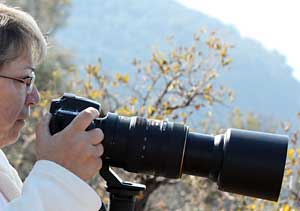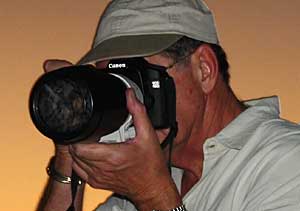Contact Details: Scotch Macaskill, Dirt Road Traders, Currys Post Road, Howick, KwaZulu-Natal, South Africa. Tel: +27 (0)82 578 2329. Privacy: Your privacy is guaranteed. See our Privacy Policy for more. This site accepts advertising and other forms of compensation - see Disclosure and Advertising for details. Site updated: 2022. Copyright © 2002 - 2022 Scotch Macaskill

| ||||||||||
|
||||||||||
|
SEE ALL |
Wildlife Camera Starter KitQuestion: I would be enormously grateful for any advice you can offer, based on your wildlife photography experience. I'm going on two trips to wildlife refuges and I'd like to take pictures of the wildlife.I need to buy a camera. I can read, and read, and read about wildlife cameras on the internet, but I would appreciate hearing thoughts from an experienced photographer. If you could spend about $1,000 (give or take), and you prefer ease of use, and best possible quality, can you suggest a camera or two? Reply: At the outset, I need to explain that I'm a Canon user and have been for the last 20 years. Although I'm not a brand fanatic and, in the past, have used Nikon, Olympus, Pentax, and Minolta gear, my current experience is very much limited to Canon cameras and lenses. While there are many reputable camera brands today, including Olympus, Pentax, Sony, Panasonic etc, I recommend choosing either Canon or Nikon bodies as the foundation on which to build a wildlife photography starter kit.
Also, independent lens makers like Sigma, Tokina, and Tamron also offer an extensive range of lenses with Canon or Nikon mounts. So I'm going to restrict my suggestions to Canon and Nikon. I have no idea of your level of photographic experience or expertise, but you've clearly done research and are prepared to spend around $1,000, which suggests you're wanting more than a camera that you'll leave on full automatic. You do mention "best possible quality", so I'll start off by recommending two digital SLR (single lens reflex) cameras that, with two lenses each, are close to the $1,000 budget. Canon Wildlife Starter Outfit Looking at Canon first, their entry-level digital SLR is the Canon EOS Rebel T3 (EOS 1100D outside the US). It's a very capable 12MP camera, can shoot video, and costs around $550 with the versatile Canon EF-S 18-55mm image-stabilized kit lens, a useful "standard" zoom for scenics, group shots, interiors and general all-round photography. I'd match that with the Canon EF 70-300mm f/4-5.6 IS USM Zoom Lens that costs around $500, so total cost would be around $1050 and you'd be pretty well covered from 18mm to 300mm. Taking into account the Rebel T3's 1.6x crop factor, that's the same angle of view as 28.8mm to 480mm on a full-frame camera. I have a fairly old Canon EF 70-300mm lens and it's fine for much of my wildlife photography. It's fairly "slow" with a maximum aperture of f/5.6 when used at 300mm, but is image-stabilized so one can hand-hold it in most situations. In low light, you can always push the ISO up to 800 to give you a faster shutter speed to reduce camera shake. The lens is recognised for being very sharp, although the build quality is not great and the barrel does extend quite far when you zoom out. It does have a lock so you can lock it at 70mm when carrying it around and this prevents "lens creep", i.e. the lens doesn't creep out to its full extension when carrying it around your neck, with the body and lens facing downwards. The lens gets a rating of 8.9 from users on Fred Miranda's site. Interestingly, a number of reviewers bought second-hand copies, so that's also worth looking into as there must be good used ones available. The lens has been around for a while, so doesn't have the very latest image stabilizer technology, but mine is certainly effective when hand-holding. Nikon Wildlife Starter Outfit The equivalent Nikon body is the Nikon D3100 14.2MP Digital SLR Camera. Fitted with a Nikon 18-55mm f/3.5-5.6 AF-S DX VR Nikkor kit lens, the price is around $580. In comparing the Nikon D3100 to the Canon Rebel T3, dpreview.com says: "The Nikon D3100, which is from a price point of view quite close to the 1100D (T3), comes with a larger screen, a 1080p full HD video mode, higher maximum ISO, more AF points and a more powerful built-in flash". Purely from what I've read, a good tele zoom lens for wildlife photography that you could add to this outfit is the Nikon 55-300mm f/4.5-5.6G ED VR AF-S DX Nikkor Zoom Lens. It's priced around $325 and will give you an angle of view equivalent to a focal length of 82.5mm to 450mm on a full-frame camera -- very adequate for most wildlife photography. So the full outfit, which will give you lens coverage from 18mm to 300mm (27mm to 450mm equivalent), will cost you around $905 -- about $145 less than the Canon outfit. Here's what one reviewer has to say on Amazon about the Nikon 55-300mm: "This is our 'go to lens'. We have a 55-200 as well as an 80-400 mm. This is the best all round lens of the three. We do a lot of wildlife photography, and, except at the farthest distances, this lens FAR out performs the 400 mm. It offers fast autofocus, reliable Vibration Reduction, crisp images, light weight. It is just an excellent all round lens for nature photography." Another says of the vibration reduction: "VR has been a lifesaver. Trying to shoot this at 300mm handheld without VR isn't fun. I have been very impressed with how well this works and always have it on." Nikon 70-300mm zoom lens The other lens to consider mating with the Nikon D3100 is the Nikon 70-300mm f/4.5-5.6G ED IF AF-S VR Nikkor Zoom Lens. At the time of writing, this is currently around $470 on Amazon but is quite a bit more at $529.95 from B&H. It gets a rating of 9 from users on Fred Miranda.
Although it doesn't have quite the same zoom range as the 55-300, it is a slightly more advanced lens, hence the higher price tag. It has IF (internal focus) that provides quiet and fast autofocusing, is apparently slightly shorter in length but is heavier than the Nikon 55-300 (1.6 lbs vs 1.2 lbs). This lens with the D3100 will cost you around $1,050 from Amazon, much the same as the Canon T3 with the Canon 70-300mm. I'd go into a camera store and try holding both cameras to get an idea if one suits you better as there's very little to choose between them, although to me the Nikon body sounds slightly better. Okay, I don't want to cloud the issue further, but I am going to throw one curve-ball! Digital Superzoom Compact Camera If making large prints is not important to you, I'd also suggest you look at a digital superzoom compact camera rather than an SLR, for the following reasons:
Today 24x, 40x and even 50x zooms are common, giving an astounding range of focal lengths. I'm not going to go into any depth discussing these cameras, but if you feel this would be adequate, I'd definitely look at the Canon SX50 HS 12.1MP Digital Camera with 50x Optical Image Stabilized Zoom This camera, around $430 on Amazon at time of writing, is one I've seriously thought of buying and sometimes, when I want to downscale and simplify my life, I even think of getting rid of my SLR gear and using only this or similar superzoom camera for wildlife and nature photography. The image-stabilized lens covers you from wide angle to super telephoto -- the equivalent of 24 to 1200mm on a 35mm film camera or full-frame digital SLR. To put this in perspective: to get that reach on a full-frame Canon digital SLR camera, you'd need a 600mm lens with a 2x converter -- about $12,000 worth of lens! Except for birds, 1200mm is overkill for most animals, but does allow you wonderful close-ups of eyes, paws, and other features of the animal. In summary, my recommendations for a wildlife camera starter kit are:
Return to Photo Info page for more photography articles. |
|||||||||
|
|
||||||||||

